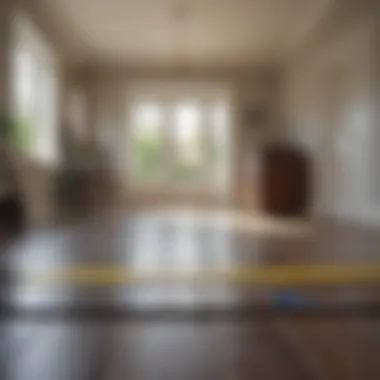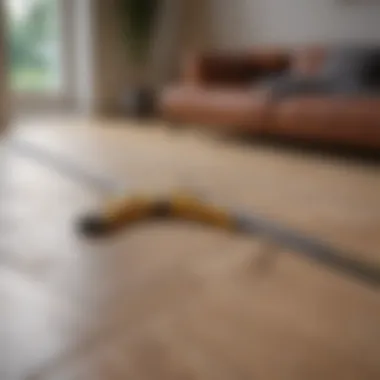Expert Guide on How to Measure House Square Footage for Flooring Success


Accurately measuring the square footage of a house is crucial when determining flooring requirements. This detailed guide will walk you through the essential steps and techniques needed for a successful flooring project.
Understanding the Importance of Precise Measurements
Before embarking on any flooring project, it is vital to comprehend why accurate measurements are indispensable. The square footage of a house directly influences the amount of flooring materials needed, preventing wastage and ensuring a cost-effective approach.
Utilizing Effective Measurement Techniques
To measure the square footage of a house effectively, start by dividing the house into measurable sections. Use a tape measure to determine the length and width of each room, calculating the square footage by multiplying these dimensions. Additionally, consider irregularly shaped rooms by dividing them into smaller, more manageable shapes for accurate measurement.
Integrating Technology for Enhanced Precision
In this digital age, technology offers valuable tools for precise measurements. Utilize laser measuring devices or apps that allow you to input room dimensions, automatically calculating the square footage. These technological advancements streamline the measuring process and reduce the margin of error significantly.
Synthesizing Information for Optimal Flooring Choices
By following these meticulous measurement techniques and utilizing technology where applicable, you can make informed decisions when selecting flooring materials. Accurate measurements enable you to choose the right amount of flooring, avoiding unnecessary expenses and ensuring a seamless installation process.
Introduction
The significance of accurately measuring the square footage of a house for flooring cannot be overstated. It plays a pivotal role in ensuring a successful flooring project, impacting various aspects such as material estimation, installation efficiency, and cost management. By obtaining precise measurements, individuals can avoid the pitfalls of inadequate or excessive flooring materials, leading to a seamless and cost-effective renovation process. Additionally, accurate measurements contribute to enhancing the overall aesthetics and functionality of the living space, making it a key determinant of project success.
Importance of Accurate Measurements
Avoiding Excess or Insufficient Flooring Material
Discussing the avoidance of excess or insufficient flooring material is crucial in highlighting the repercussions of inaccurate measurements. By ensuring precise calculations, individuals can eliminate the need for costly reorders or wastage, optimizing resource utilization. This aspect underscores the efficiency and sustainability of the flooring project, emphasizing the importance of meticulous measurement techniques in achieving optimal outcomes.


Precision in Cost Estimation
Precision in cost estimation is paramount for effective budget planning and resource allocation. Accurate measurements enable individuals to calculate material expenses with accuracy, preventing budget overruns and financial constraints. By prioritizing precision in cost estimation, stakeholders can streamline the procurement process, optimize spending, and enhance project profitability, showcasing the strategic value of meticulous measurement practices.
Enhancing Installation Efficiency
Enhancing installation efficiency through accurate measurements is instrumental in minimizing time wastage and operational disruptions. By providing installers with exact dimensions, individuals can expedite the installation process, ensuring timely project completion. This enhanced efficiency not only accelerates the renovation timeline but also reflects a commitment to quality craftsmanship, highlighting the operational benefits of meticulous measurement methods.
Tools Needed for Measurement
Tape Measure
The tape measure is a fundamental tool for measuring the dimensions of a space accurately. Its flexibility and ease of use make it a preferred choice for obtaining precise measurements, ensuring consistency and reliability in the calculation process. With its portability and versatility, the tape measure aids individuals in capturing accurate data swiftly, emphasizing its indispensable role in executing successful flooring projects.
Calculator
Utilizing a calculator is essential for expedited and error-free calculations, especially when dealing with complex floor areas and multiple measurements. Its capability to perform rapid computations enhances decision-making accuracy, enabling stakeholders to assess material requirements and costs efficiently. The calculator's convenience and mathematical precision make it an invaluable asset for achieving measurement precision in flooring projects.
Graph Paper or Floor Plan
Graph paper or floor plans serve as visual aids in organizing and interpreting measurement data effectively. By translating measurements onto a scale drawing, individuals can visualize the spatial layout, identify irregularities, and plan flooring installations with precision. The strategic use of graph paper or floor plans enhances spatial awareness and fosters informed decision-making, underscoring the practical utility of visual representation in measurement tasks.
Basic Calculation Method
Divide the Area into Basic Shapes
Dividing the area into basic shapes facilitates simplification and accuracy in measurement computation. By breaking down complex floor plans into elementary geometric forms, individuals can calculate areas methodically, reducing errors and ensuring comprehensive coverage. This methodical approach streamlines the measurement process, promoting systematic analysis and precise data aggregation for optimal flooring planning.
Measure Each Section


Measuring each section individually is essential for capturing nuanced spatial dimensions accurately. By focusing on specific zones within the floor space, individuals can account for irregularities and variations, ensuring meticulous coverage. This granular measurement technique enhances data accuracy, enabling thorough assessment and informed decision-making in flooring material allocation and installation scheduling.
Summing up the Areas
Summing up the areas of individual sections consolidates measurement data for comprehensive project planning. By aggregating calculated areas, stakeholders can derive the total square footage requirements, facilitating material procurement and cost estimation. This cumulative approach simplifies the data analysis process, enabling a holistic view of flooring needs and supporting strategic decision-making for a successful renovation outcome.
Advanced Measurement Techniques
Using Digital Apps for Precision
Leveraging digital apps for precision measurement offers advanced capabilities for accurate data collection and analysis. Digital tools provide automated calculations, real-time adjustments, and detailed floor area visualizations, enhancing measurement efficiency. By harnessing technology for measurement tasks, individuals can elevate the accuracy and speed of data processing, optimizing project planning and execution with cutting-edge measurement solutions.
Laser Measuring Devices
Employing laser measuring devices revolutionizes measurement accuracy and efficiency, enabling precise distance calculations and area delineation. These devices offer laser-guided measurements, minimn
Considerations for Oddly Shaped Rooms
Breakdown into Smaller Sections
Breakdown into smaller sections is a strategic approach to managing measurements in irregularly shaped rooms. By dividing complex areas into manageable segments, individuals can capture detailed dimensions effectively, reducing errors and oversights. This methodical breakdown enhances measurement precision, enabling a systematic analysis of spatial intricacies and facilitating targeted flooring solutions for challenging room layouts.
Utilize Approximation Techniques
al
Factoring in Wastage and Cut Pieces


Calculating Percentage for Waste
Calculating the percentage for waste is essential for optimizing material utilization and cost efficiency. By estimating waste percentages accurately, individuals can minimize resource overages and control project expenses. This meticulous approach to waste calculation supports sustainability goals and operational cost management, underscoring the importance of prudent material planning in flooring projects.
Accounting for Additional Cuts
Accounting for additional cuts involves factoring in surplus material requirements for cutting and fitting purposes. By preemptively accounting for extra cuts, individuals can address installation contingencies and ensure seamless flooring executions. This proactive strategy mitigates last-minute challenges and enhances installation precision, demonstrating a comprehensive approach to material planning and project execution in flooring renovations.
Conclusion
In the culmination of this comprehensive guide on measuring square footage for flooring, the importance of precision is paramount. Accurate measurements lay the foundation for a successful flooring project, ensuring the right amount of materials are procured. Without precise measurements, the risk of dealing with excess or insufficient flooring material looms large. This inefficiency not only affects the cost estimation but also impedes the installation process, leading to delays and potential rework. By emphasizing precision in measurement, individuals can optimize their resources, streamline their projects, and achieve desirable outcomes.
Ensuring Precision in Measurement
Double-Check Measurements
The practice of double-checking measurements serves as a fundamental aspect of ensuring accuracy in the flooring measurement process. This step involves reevaluating the dimensions and calculations to rectify any potential errors or discrepancies. By cross-verifying the measurements, individuals can mitigate the risks of inaccuracies and misjudgments, ultimately enhancing the reliability of the final calculations. Double-checking measurements instills confidence in the data provided, reducing the likelihood of costly mistakes and rework.
Professional Verification if Uncertain
In instances where uncertainties persist regarding the accuracy of measurements, seeking professional verification becomes indispensable. Professional verification entails consulting with experts in the field, such as architects or interior designers, to validate the measurements and provide insights on potential discrepancies. By leveraging professional expertise, individuals can address complex measurement challenges and ensure the integrity of the data collected. This collaborative approach not only validates the measurements but also enhances the overall credibility of the flooring project.
Maintaining Accuracy for Flooring Success
The sustained accuracy of measurements is integral to the success of any flooring project. By maintaining precision throughout the measurement process, individuals can minimize deviations and variations in the data, leading to consistent and reliable results. This commitment to accuracy not only facilitates efficient material planning and cost estimation but also fosters smooth implementation and execution. As a critical component of flooring success, maintaining accuracy underscores the importance of meticulous attention to detail and precision in every measurement taken.
Final Thoughts
Measurement as Foundation for Flooring Excellence
The act of measurement serves as the cornerstone of flooring excellence, shaping the trajectory of the project from inception to completion. Accurate measurements provide the necessary framework for decision-making, enabling individuals to plan effectively, procure materials efficiently, and execute tasks with precision. By recognizing measurement as the foundation for flooring excellence, individuals can elevate the quality of their projects and achieve optimal outcomes that align with their expectations.
Applying Knowledge in Future Projects
The insights gained from the measurement process are invaluable assets that can be applied to future projects, enhancing proficiency and expertise. By assimilating knowledge acquired from measuring square footage, individuals can refine their approaches, troubleshoot potential challenges, and optimize their strategies for future endeavors. This iterative learning process not only cultivates continuous improvement but also fosters a culture of innovation and adaptation within the realm of flooring projects.



